
Ladder Safety
Ladders are built from one of three basic materials; wood, fiberglass and metal (aluminum).
The environment of your work site is the first factor in choosing the material from which your ladder is constructed. For example, if you are working near sources of electricity, a metal ladder should be rejected since aluminum is an electrical conductor. Your body can complete an electrical circuit between the electrical power source, the ladder, and then to the ground in the event of a live wire contact incident. An electrical shock while working from a ladder can trigger a fall or cause your heart to stop leading to serious injury or death.
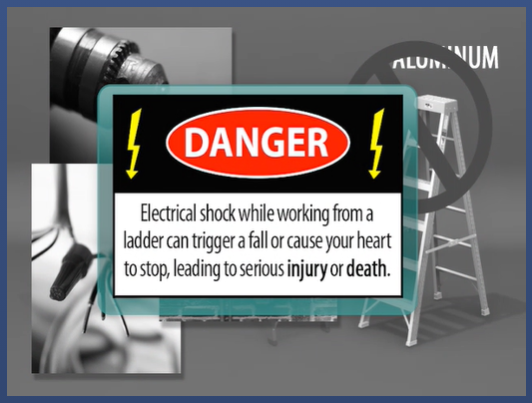
On the other hand, if there are no electrical power sources in your work area, the aluminum ladder is the lightest weight when compared to fiberglass or wood.
There are also several kinds of ladders manufactured for a variety of uses. Again, evaluation of your work environment and knowledge of what ladders are available will allow you to choose the right ladder for the job. Each of the following considerations addresses safety issues in your work environment:
- Will the ladder be resting on an uneven surface?
- Is the work area crowded with people and/or materials?
- What obstructions are in the path of the climb?
Next, the proper ladder length must be selected. It is unsafe to use a ladder that is too long or too short. When using a Step Ladder,for example, standing on the top cap or the step below the top cap is not permitted due to the increased likelihood of losing your balance. Likewise, when using an Extension Ladder, the top three rungs are not to be used for climbing. A Straight Ladder is too long, for example, if ceiling height prohibits the ladder from being set-up at the proper angle. Likewise, an Extension Ladder is too long if the ladder extends more than three (3) feet beyond the upper support point. In this case, the portion of the ladder that extends above the upper support point can act like a lever and cause the base of the ladder to move or slide out. Safety standards require a label on the ladder to indicate the highest standing level.
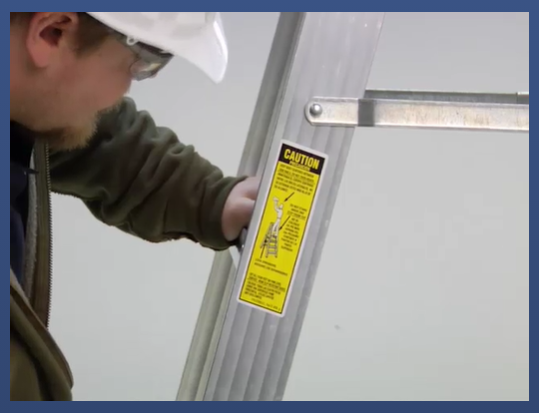
Next, consider the Duty Rating of the ladder. This is an indication of the maximum weight capacity the ladder can safely carry. To figure out the total amount of weight your ladder will be supporting, add:
- Your Weight; plus
- The Weight of Your Clothing and Protective Equipment; plus
- The Weight of Tools and Supplies You Are Carrying; plus
- The Weight of Tools and Supplies Stored on the Ladder
There are five categories of ladder Duty Ratings:
|
Type IAA (Extra Heavy Duty) |
375 pounds |
|
Type IA (Extra Heavy Duty) |
300 pounds |
|
Type I (Heavy Duty) |
250 pounds |
|
Type II (Medium Duty) |
225 pounds |
|
Type III (Light Duty) |
200 pounds |
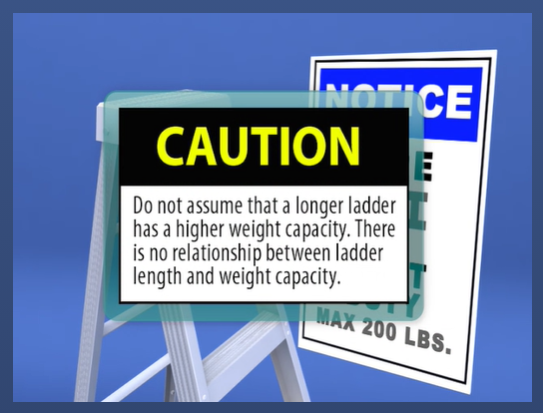
The Duty Rating of your ladder can be found on the specifications label. Safety standards require a Duty Rating sticker to be placed on the side of every ladder. Do not assume that a longer ladder has a higher weight capacity. There is no relationship between ladder length and weight capacity.
Ladders are tools. Many of the basic rules that apply to most tools also apply to the safe use of a ladder:
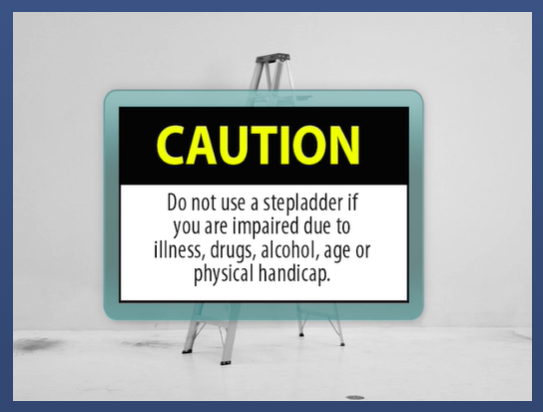
- If you feel tired or dizzy, or are prone to losing your balance, stay off the ladder.
- Do not use ladders in high winds or storms.
- Wear clean slip-resistant shoes. Shoes with leather soles are not appropriate for ladder use since they are not considered sufficiently slip resistant.
- Before using a ladder, inspect it to confirm it is in good working condition.
- Ladders with loose or missing parts must be rejected. Rickety ladders that sway or lean to the side must be rejected.
- The ladder you select must be the right size for the job.
- The Duty Rating of the ladder must be greater than the total weight of the climber, tools, supplies, and other objects placed upon the ladder. The length of the ladder must be sufficient so that the climber does not have to standon the top rung or step.
- When the ladder is step-up for use, it must be placed on firm level ground and without any type of slippery condition present at either the base or top supports.
- Only one person at a time is permitted on a ladder unless the ladder is specifically designed for more than one climber (such as a Tresle Ladder).
- Ladders must not be placed in front of closed doors that can open toward the ladder. The Door must be blocked open, locked, or guarded.
- Read the safety information labels on the ladder.
- The on-product safety information is specific to the particular type of ladder on which it appears. The climber is not considered qualified or adequately trained to use the ladder until familiar with this information.

Factors contributing to falls from ladders include haste, sudden movement, lack of attention, the condition of the ladder (worn or damaged), the user's age or physical condition, or both, and the user's footwear.
Although the user's weight or size typically does not increase the likelihood of a fall, improper climbing posture creates user clumsiness and may cause falls. Reduce your chances of falling during the climb by:
- wearing slip-resistant shoes with heavy soles to prevent foot fatigue;
- cleaning the soles of shoes to maximize traction;
- using towlines, a tool belt or an assistant to convey materials so that the climbers hands are free when climbing;
- climbing slowly and deliberately while avoiding sudden movements;
- never attempting to move a ladder while standing on it;
- keeping the center of your belt buckle (stomach) between the ladder side rails when climbing and while working. Do not overreach or lean while working so that you don't fall off the ladder sideways or pull the ladder over sideways while standing on it.
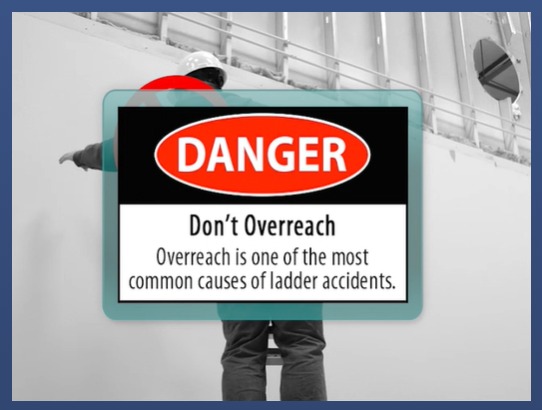
Image: American Ladder Institute - Step Ladder Safety Training Video
The Three Point-of-Contact Climb
When climbing a ladder, it is safest to utilize Three Points-of-Contact because it minimizes the chances of slipping and falling from the ladder. At all times during ascent, descent, and working, the climber must face the ladder and have two hands and one foot, or two feet and one hand in contact with the ladder steps, rungs and/or side rails. In this way, the climber is not likely to become unstable in the event one limb slips during the climb.
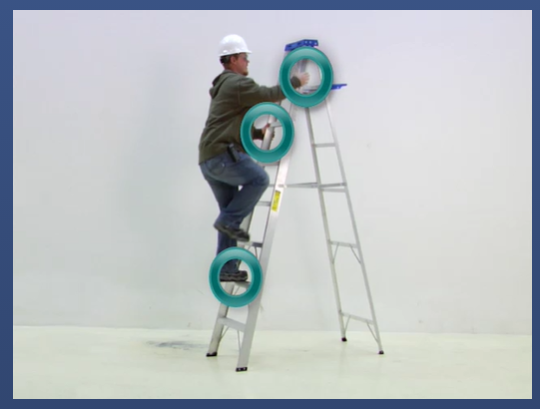
It is important to note that the climber must not carry any objects in either hand that can interfere with a firm grip on the ladder. Otherwise, Three Points-of-Contact with the ladder cannot be adequately maintained and the chance of falling is increased in the event a hand or foot slip occurs.
|
Ladder Varieties Your work environment, including the physical size restrictions, is probably the most important factor in determining the variation of ladder to use for a given job. The versatility of the ladder, however, is a major consideration, especially for domestic use. Otherwise, the number of ladders that one would need to have available for the wide variety of tasks around the home that require elevation from the ground would be prohibitive. In an effort to assist in familiarizing yourself with the standard ladder variations that are available, check out the ladder types in the right sidebar.
|
Contact Info
Mark Musser, Chemical Hygiene Officer (CHO)920-403-4019
mark.musser@snc.edu













